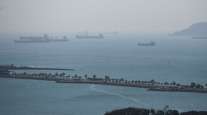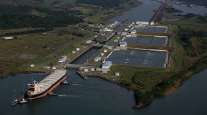Jumbo Cargo Ships Crossing Daily as Panama Canal Use Ramps Up

This story appears in the Aug. 8 print edition of Transport Topics.
Initial containership traffic through the expanded Panama Canal is averaging about one larger vessel per day during a ramp-up period that should be followed by exponential growth in the months and years ahead.
The Panama Canal Authority announced Aug. 2 that 40 container vessels have transited the waterway since the June 26 inauguration of the $5.25 billion project.
The pace should increase in the months ahead because 160 reservations already have been placed for container vessels in the next several months, according to the authority.
Economist Walter Kemmsies, chief strategist for the port, airport and global infrastructure group at global real estate firm Jones Lang LaSalle, told Transport Topics last week that container vessel transits should double during the third quarter and keep rising.
The number of daily trips by Neopanamax vessels could reach as many as six in as little as six months, he said, though key factors such as container industry capacity and related railroad strategy will determine how much cargo shifts from West Coast ports to East Coast and Gulf of Mexico ports as a result of the canal expansion.
The expanded canal now can accommodate vessels carrying as many as 14,000 industry- standard 20-foot-equivalent units, or TEUs. The previous limit was 5,000 TEUs.
By comparison, about nine of the smaller containerships passed through the canal daily in the 12 months ended Sept. 30, according to the authority’s latest annual report.
“We are very pleased with the first month of operations at the expanded canal since the inauguration,” said Panama Canal Administrator Jorge Quijano. “The increasing demand is further evidence of the mari-time industry’s continued trust in the expanded canal and the great impact it will have on the future of world maritime trade.”
“The shift [between U.S. coasts] has already started,” Kemmsies said, tracing the transition back nearly a decade. After Panama’s voters approved expansion in 2006, ocean carriers began ordering larger vessels, expecting to deploy them when the expanded canal opened in 2014. Instead, the date was delayed nearly two years by cost and engineering issues.
“Now that the project is complete, there will be tremendous changes,” he said.
Just before the June 26 inauguration, Maersk Line and Mediterranean Shipping Co., the two largest ocean carriers, said they would switch some Asia-East Coast routings to the expanded Panama waterway from the Suez Canal, which separates Africa from the Middle East.
Kemmsies said that shift began two or three years ago, based on freight industry statistics. Railroads’ capital commitment will be a key factor in future shifts, he said. In the East, CSX and Norfolk Southern could gain market share from western railroads that today move Asian cargo cross-country.
He cited strong real estate markets near major East Coast ports to underscore the expectation of growth there.
“I think it’s still too early to determine how large a West to East Coast shift might be, but our view is that it will be small,” consultant Daniel Hackett of Hackett Associates said.
There aren’t any immediate indicators of a cargo shift in July, because none of the U.S. ports had reported July container shipment volumes as TT went to press.
Kemmsies said the pace of larger ships transiting the Panama Canal will depend on broad future industry capacity trends, which will be tied to how quickly smaller, less efficient ships are scrapped. He believes as many as 20% of older vessels could be pulled from the market.
Kemmsies also said that ships larger than the current range of up to 10,000 TEUs will advance to as much as 12,000 TEUs.
“There is a learning curve with a new service,” he said. In Panama, that includes a shift to using tugboats instead of small locomotives to move ships.




